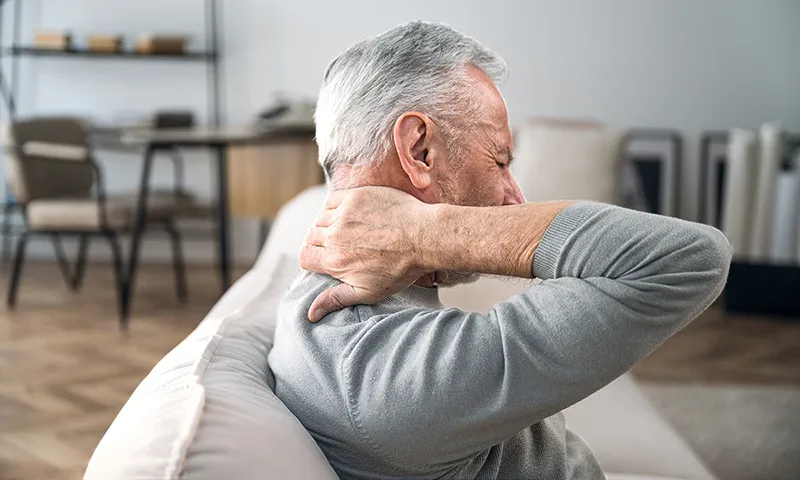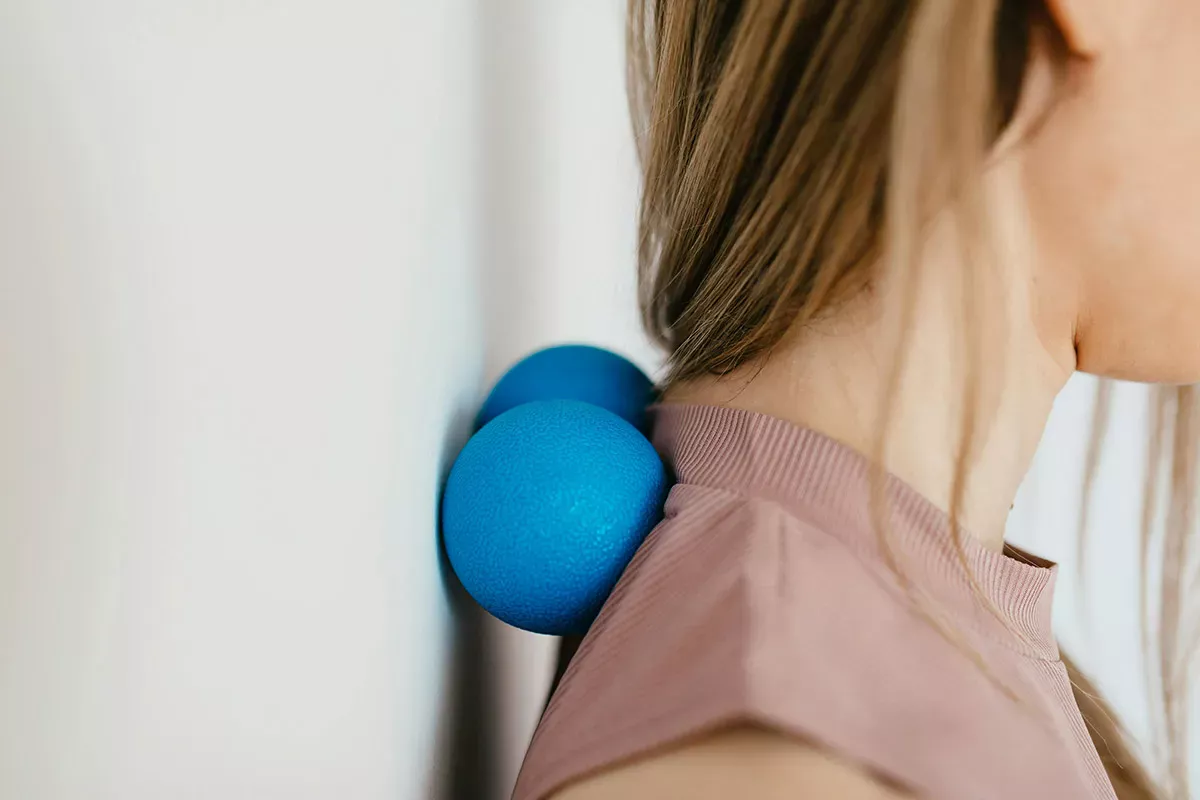Frequency & types of neck pain
Many people suffer from neck pain: in a survey conducted in 2020, almost 50 per cent of Germans surveyed stated that they had experienced neck pain in the previous year. Women suffer from neck pain slightly more often than men. In general, the risk of chronic neck pain increases with age. Not all neck pain is the same: doctors differentiate between specific and non-specific neck pain on the one hand and between acute and chronic neck pain on the other.
Specific vs. non-specific neck pain
In the case of specific neck pain, there is a specific cause for the neck pain - for example, a pinched nerve root or an injury to the intervertebral discs or vertebrae. Specific neck pain must be treated by a doctor.
However, non-specific neck pain, which is usually triggered by tension, is much more common. There is no clear starting point here.
Acute vs. chronic neck pain
Acute neck pain usually goes away within a few days to three weeks and is no reason to panic. It is usually caused by tension.
If neck pain has not disappeared after 12 weeks, it is referred to as chronic neck pain. This is usually caused by wear and tear.
Causes: Why do we have neck pain?
In most cases, tension is the cause of neck pain. In this chapter, you can find out how this happens and what other causes neck pain can have.
Neck pain due to tension
The muscles in the neck and nape area have an important task: they not only have to support our heavy head, but also ensure that it can turn in all directions. We need the neck muscles to turn our head to the right and left when we want to cross a road and also when we look upwards to look at the sky. Ideally, we should use our neck muscles regularly for all these movements so that the muscles are balanced. It becomes problematic if we strain our neck muscles unilaterally and always remain in the same - possibly neck-unfriendly - posture. If some muscles are used very heavily and others are very weak, an imbalance occurs: the muscles shorten and tension builds up.
However, it is not only muscle tension in the neck area that can lead to neck pain. Disorders in other parts of the body can cause a spiral of tension throughout the body and also trigger neck pain. For example, if the pelvis is misaligned, the spine tries to compensate for the imbalance. This creates tension that accumulates in the muscles and fascia in the neck. Fascia is a fibrous connective tissue that envelops all the muscles and organs of the human body. When we move sufficiently, the fascial tissue is supple. However, one-sided strain and lack of movement can cause the fascia to stick together and trigger pain.
Good to know:
If you also have jaw or headaches or grind your teeth in addition to your neck pain, this could be due to craniomandibular dysfunction - a disorder of the balance of chewing function.
Neck pain due to sitting for too long
In our modern lives, we look forwards or downwards much more often than sideways or upwards. When working on a PC, scrolling on a mobile phone or tablet and even at the wheel of a car, the head is stretched too far forward. This posture is unfavourable for the neck because the muscles have to tense up much more than with a normal upright posture.
When typing on a PC, the shoulders are often pushed forwards as well. As a result, most people who spend long periods of time in front of a PC automatically adopt a rather rounded posture. If this poor posture becomes a permanent condition, we speak of a "hunched back": This is when the muscles and fascia at the front of the body shorten because the hands are permanently in front of the body. As we already know, shortened muscles lead to tension. As many people spend many hours a day sitting at a desk as part of their job, this is one of the most common causes of neck pain.
Neck pain due to incorrect sleeping position
If you wake up in the morning with neck pain after sleeping, you probably slept in the wrong position during the night. Many people like to sleep on their side in the so-called foetal position. What feels comfortable and cosy in bed is unfortunately not ideal for your neck: the muscles in the side sleeping position are actually shortened in a similar way to the posture at a desk. The arms are in front of the body, the legs are bent and the back is rounded. The strain is somewhat less than in a sitting position because the head lies on the pillow and does not have to be supported. Nevertheless, this sleeping position can favour neck pain.
The sleeping position on the stomach is even worse, as the stomach sleeper has to twist their neck when they rest their head on the pillow. The ideal position is lying on your back with a pillow that is as flat as possible.
Good to know:
Speaking of nights: did you know that every second person grinds their teeth at least temporarily during the course of their life? You can find out the reasons for this and how to get rid of this annoying habit in our article:
Physical strain at work
Not everyone has a desk job and runs the risk of developing a hunched back. People who carry out physically demanding work and frequently assume a hunched posture - for example in the construction industry or in elderly care - also have an increased risk of neck pain. People in these professions often unconsciously adopt an incorrect posture in which the shoulders are raised and the head is stretched forwards. The constant strain creates an imbalance in the muscles and fascia. The result: neck pain.
Occupations that require you to constantly look upwards - for example painters - are also unfavourable for the neck muscles.
Neck pain after sport
In principle, sport is a good remedy for neck pain - but not always. Certain sports can either aggravate or even trigger neck pain because the neck is in an unfavourable position. These include, for example, road cycling and breaststroke swimming with your head above the water. If you suffer from neck pain after swimming, you should either swim on your back, crawl or use swimming goggles when swimming breaststroke and keep your head under water when exhaling.
Just as with physical occupations, neck pain can also occur after strength training in the gym if you adopt the wrong posture.
If you have neck pain after jogging, this may be an indication of incorrect running technique. When running, make sure that you lean your body slightly forwards from the hips and not from the back.
Neck pain from rucksack or handbag
Women in particular will be familiar with this problem: If you carry a heavy handbag over your shoulder for a long time, the one-sided strain will eventually lead to tension and neck pain on the side of the bag. The shoulder is constantly pulled up so that the bag handle cannot slip off and the freedom of movement of the arms is also restricted. This creates an imbalance in the spine, which can lead to postural problems in the long term. It is better for the neck to wear a rucksack or to alternate between a rucksack and a handbag.
However, an overloaded rucksack can also cause neck pain - for example in children who have to carry several heavy school books around with them every day. If we carry a backpack that is too heavy, we automatically bend forwards and adopt a posture that is not good for the neck, similar to a hunched back. Both your rucksack and handbag should not be heavier than five per cent of your body weight. If you are carrying a heavier rucksack - on a hiking holiday, for example - you should make sure you adjust the rucksack correctly.
Neck pain due to draughts
If our neck is exposed to cold air without protection, the muscles automatically tense up, which can lead to tension and consequently neck pain. This applies to draughts as well as fans and air conditioning systems. Problems occur particularly quickly when the body is sweaty or the temperature difference between outside and inside is over six degrees.
Neck pain due to stress
Neck pain can also be caused by mental stress: When we are stressed, we are tense. This is why psychological stress often manifests itself in muscle cramps and tension in the neck. For example, stress at work, financial worries or relationship problems can trigger neck pain. The already unfavourable sitting position at the desk is also exacerbated by stress: when we are stressed, we unconsciously pull our shoulders up, which leads to additional tension in the neck muscles. People with psychosomatic illnesses suffer particularly frequently from chronic neck pain.
Neck pain after surgery
It's not surprising if you wake up with neck pain after an operation. Patients lie on the operating table in an unchanged position for a long time, especially during lengthy operations under general anaesthetic. Unlike during sleep, they cannot adjust their lying position and can therefore easily shift. This can lead to muscle tension. Dental operations and other operations where the mouth has to remain open for long periods of time are particularly stressful for the muscles in the face and neck.
Good to know:
Are you about to undergo a lengthy dental treatment? Here you will find an overview of the various anaesthetic options:
Neck pain after a car accident or fall
After a car accident, neck pain can be a sign of whiplash: If a rear-end collision results in a surprisingly strong jolt that causes an abrupt movement of the head, muscle strains and tensions occur because the relaxed neck muscles were not prepared for the movement. In addition to severe neck pain, headaches, dizziness and general drowsiness as well as visual disturbances can also occur.
Physical wear and tear
Our years of life do not pass without leaving their mark on the cervical spine. Even if this is much less common than neck pain caused by tension, physical wear and tear can also be the cause of neck pain. This usually occurs either at an advanced age or becomes noticeable earlier after prolonged poor posture.
The following signs of wear and tear can cause neck pain:
- Slipped disc
- Osteoarthritis (joint wear and tear)
- Spondylosis (stiffening of the spine)
- Chondrosis (wear and tear of the intervertebral discs)
- Cervical spinal canal stenosis (narrowing of the spinal canal)
- Osteoporosis (bone loss)
- Rickets (disorder of bone growth)
Hormones
Changes in hormone levels can cause neck pain in women - this applies to menstruation, the menopause and pregnancy. In addition, postures that women adopt due to menstrual cramps or weight gain during pregnancy can favour or exacerbate neck pain. Many women also unconsciously adopt a poor posture when breastfeeding, which can lead to tension. A helpful tip: Mothers should consciously push their shoulders down before breastfeeding.
Good to know:
Did you know that pregnancy can have an impact on your dental health? You can find everything you need to know about this topic here:
Diseases
Neck pain can also be a symptom of an illness. However, before you read through the list and worry that your neck pain could be a sign of cancer or meningitis, remember: in most cases, tension is the cause of neck pain. You can find out when you should go to the doctor if you have neck pain in the "Diagnosis" section.
Neck pain can be a symptom of the following conditions, among others:
- Cold
- Flu
- Covid-19 ( Corona )
- Chronic fatigue syndrome (in combination with excessive fatigue )
- Multiple sclerosis ( MS )
- Rheumatoid arthritis
- Cervical spine syndrome
- Tick-borne encephalitis (TBE)
- Lyme disease
- Fibromyalgia (chronic pain disorder)
- Meningitis (inflammation of the meninges)
- Heart attack (especially in women)
- Stroke
- Tumour or metastasis in the neck area
Good to know:
If you experience neck pain around two weeks after a tick bite and at the same time suffer from a headache at the back of your head and are sensitive to light, this could be a sign of tick-borne encephalitis (TBE). Find out what to do now here:
Symptoms
Doctors distinguish between two forms of neck pain: Axial neck pain primarily affects the cervical spine. However, it can also extend to the shoulders. Radicular neck pain also radiates to other parts of the body - for example to the back of the head, the ear or an arm. This form of neck pain runs along the nerve pathways. It occurs, for example, when an intervertebral disc pinches a nerve.
The following symptoms can occur together with neck pain:
- Hardened neck muscles (unilateral or bilateral)
- Burning pain in the neck (unilateral or bilateral)
- Sharp headache in the back of the head
- Stiff neck (limited mobility)
- Pain when turning the head
- Headache
- Shoulder pain
- Pain when coughing
- Sore throat
- Earache
- Dizziness
- Tinnitus
- Migraine
- Jaw and tooth pain
- Swallowing difficulties
- Shallow breathing
- Intervertebral disc problems
- Inflammation of the shoulder
- Eye pain
- High blood pressure
Interesting fact: neck pain can trigger high blood pressure. When patients get their neck pain under control, their blood pressure often drops too.
Diagnosis: When to see a doctor for neck pain?
If your neck pain is caused by tension, it should disappear on its own within a few days to weeks - at least if you have identified and eliminated the cause of the tension. This does not necessarily require a visit to the doctor. However, you can ask your doctor to prescribe physiotherapy, which is particularly useful if you suffer from frequent neck pain.
You should definitely see a doctor if one of the following situations applies:
- You had an accident.
- The pain lasts longer than 12 weeks or comes back again and again.
- In addition to the neck pain, you suffer from fever, nausea, sensitivity to light, severe headaches or prolonged dizziness.
- You feel tingling or numbness in your arms; your arms or legs often fall asleep.
- You can no longer move your head towards your chest (stiff neck).
- The pain is just as bad when lying down as when moving.
- You have difficulty moving your arm or fingers.
But which doctor is the right person to contact for neck pain? The first port of call is usually your family doctor's surgery or an orthopaedic practice. However, if the neck pain is accompanied by severe headaches, nausea, fever, dizziness or sensitivity to light, meningitis is suspected. In this case, you should call an ambulance immediately. If you suffer from tingling, numbness or mild paralysis in addition to neck pain, you may be referred to a neurologist.
Whether your doctor issues you with a sick note and how long you are unfit for work cannot be generalised and depends heavily on the individual situation.
Treatment: What helps with neck pain?
If you are currently suffering from neck pain, you probably want to get rid of it as quickly as possible. Unfortunately, there is no panacea for this: there are plenty of medications available in pharmacies - including creams or ointments such as Voltaren and painkillers such as ibuprofen and paracetamol . Some doctors also administer injections for neck pain, which anaesthetise the muscles and thus force them to relax. However, a meta-analysis has shown that injections, tablets and the like are only slightly effective for neck pain in the long term. This is why the German Society for General and Family Medicine (DEGAM) also advises against taking painkillers for non-specific neck pain.
You can of course use these remedies from the pharmacy to relieve the pain in acute cases - but not for longer than a week. To solve neck pain permanently, you need to get to the root of the problem and eliminate the cause. What really helps with neck pain are exercises that relieve tension or build up the neck muscles. We'll tell you here which exercises you can actually do and what other treatment methods are useful.
Treating neck pain with physiotherapy
To get to the bottom of the cause of your neck pain, you can ask your GP to prescribe physiotherapy. The therapist will help you to correct poor posture and show you exercises to rebalance and strengthen your neck muscles. You should repeat these exercises at home if possible.
People who suffer from neck pain have often internalised poor posture and unconsciously fall back into it again and again. The aim of physiotherapy is to permanently correct posture in order to prevent neck and back pain in the long term.
Supportive measures such as a posture trainer or biofeedback can be used to sensitise patients to their posture and give them a new body awareness. A posture trainer is a type of belt that is placed around the shoulders to remind the wearer of the correct posture. However, this type of belt should only be worn for a few hours a day. Ask your physiotherapist for advice on this. Biofeedback allows patients to see the muscle activity of their neck muscles on a screen via electrodes. The aim of this treatment is to enable those affected to consciously intervene in the muscle tension or relaxation process and regulate it themselves.
To provide relief from acute neck pain, physiotherapists can tape or massage the neck area. With kinesio taping, the therapist sticks an elasticated bandage directly onto the skin to stimulate blood circulation. A massage can promote blood circulation and loosen the muscles. Massage can also loosen adhesions in the fascia.
Exercises for neck pain at home
If your neck pain is still limited and you don't want to go straight to the doctor, you can also stretch your neck muscles at home to relieve the tension. There are already numerous videos on the internet with helpful exercises that are explained by trained physiotherapists. The videos and instructions from " Liebscher und Bracht - Die Schmerzspezialisten" are particularly popular. If you prefer yoga, you will also find numerous videos explaining how to use yoga for neck pain.
The use of a fascia roll can also help. After all, adhesions in the fascia can lead to neck pain. By slowly rolling your body over a special roller, you can loosen the connective tissue and break up adhesions. Fascia roller manufacturers often offer their own exercise videos. If you are undergoing physiotherapy treatment, your therapist will also be happy to show you how to use your fascia roll at home.
Here we have put together a few simple exercises - without fascia rolls - that can help relieve neck pain caused by tension and that you can easily integrate into your everyday life:
Exercise no. 1: Shoulder circles
You can do this exercise standing or sitting.
- Let your arms hang loosely.
- Make gentle circular movements backwards with your shoulders. Start with small circles and let the circles get bigger and bigger.
Exercise no. 2: Pulling your shoulders up and down
- Let your arms hang loosely.
- Pull up your shoulders.
- Slowly lower your shoulders again.
Exercise no. 3: Stretching the chest muscles
- Stand next to a door frame or a wall.
- Place your hand and forearm against the door frame or wall.
- Rotate the rest of the body in the opposite direction until you feel a stretch in the chest muscle.
- Hold this position for at least 30 seconds.
- Repeat the exercise on the other side.
Exercise no. 4: Stretching the trapezius muscle
You can do this exercise standing or sitting.
- Push your right shoulder down as far as possible - imagine you are reaching for the floor.
- Tilt your head to the left and bend it slightly forwards. You should now feel a stretch in the muscles at the side of your neck.
- Hold the stretch for about 30 seconds. If you want to increase the stretch, you can push your arm further down, turn your head further or place your left arm on your head.
- Repeat the exercise on the other side.
Cooling or warming?
The classic home remedy for neck pain is heat: a scarf, hot water bottle, heat plaster and even a warming red light can bring relief and relax tense muscles.
However, if your neck pain is caused by inflammation, heat can make it worse. In this case, cooling would be the better alternative. You can use a cold pack or a cold, damp flannel, for example.
Pillow against neck pain
If you often wake up with neck pain, it may well be that your sleeping equipment is the culprit. Sleeping on your back with a flat pillow is ideal. The cervical spine should be in a straight line with the thoracic spine. Under no circumstances should you lie with your shoulders on the pillow. The nose should point upwards and not forwards. Pre-shaped neck pillows can help with neck pain because they support the head and bring the cervical spine into the correct position. It is best to seek advice from a specialist shop. The pillow must be customised to your body, your sleeping position and your mattress.
Magnesium
If the body lacks magnesium, the muscles cannot relax properly - this naturally also applies to the neck area. A magnesium deficiency can lead to hardening of the neck muscles. A daily dose of 300-400 milligrams of magnesium is recommended for adults.
Alternative medicine
Alternative medicine also offers treatment approaches for neck pain. Acupuncture, for example, is said to relieve pain and get energy channels flowing. According to a scientific study, acupuncture can be helpful for acute neck pain, but only provides relief in the short to medium term.
Osteopathy uses manual techniques to release blockages and improve joint mobility. A randomised controlled study by the OsteopathieSchule Deutschland showed that both the group that had received osteopathic fascia treatment and the group that had received a placebo treatment showed a significantly greater improvement in pain and mobility than the control group that had not received any treatment. The placebo effect therefore certainly seems to play a major role. However, the participants who had received osteopathic treatment were able to turn and tilt their heads better than the placebo group. In general, there is little scientific evidence for the effect of osteopathy.
Homeopathy offers globules for neck pain. However, the effectiveness of homeopathy has not yet been scientifically proven.
Preventing neck pain: 7 tips
Of course, it's ideal if neck pain doesn't occur in the first place. Here you can find out what you can actively do to avoid pain:
1. Train your back
If you have well-trained shoulder, neck and back muscles, you are much less likely to suffer from neck pain. The following sports are particularly suitable for building up your back muscles:
- Yoga
- Pilates
- Nordic Walking
- Swimming (crawl or backstroke)
There are also special courses designed to train the back and protect it from the postural damage caused by our modern everyday lives.
2. Set up your workplace ergonomically
If you already spend many hours of the day at your desk, it should be set up to suit your body's needs. Instead of sitting at your laptop for hours on end and looking down, you should get yourself a screen. The ideal sitting position looks like this: The screen is at least 50 centimetres away from your eyes. Your gaze is slightly downwards when you are sitting upright.
A height-adjustable desk that allows you to work standing up is also a good idea. Because you don't have the same posture all the time, your muscles won't tense up so quickly. Instead of a conventional desk chair, you can also choose an ergonomic stool that automatically straightens your back and strengthens your back and neck muscles. It is particularly good if you can switch back and forth between standing, sitting and "squatting".
3. Incorporate movement and stretching into everyday office life
Instead of sitting in the same position for hours on end, you should get up and move from time to time - even if you don't have a height-adjustable desk. You can also easily integrate the exercises described above into your daily office routine. This allows you to stretch your neck muscles from time to time and prevent tension and neck pain.
4. Seize every opportunity to move
People who have an office job in particular often don't get enough exercise. To compensate for the one-sided strain of sitting for long periods, you should take every opportunity to move. This means climbing stairs instead of taking the lift, cycling to work and covering shorter distances on foot rather than by car in your free time.
5. Reduce stress
As you already know, stress can trigger physical tension and therefore also lead to neck pain. Therefore, make sure you integrate stress-reducing rituals into your everyday life: This could be a long walk in the fresh air, a hot relaxing bath with essential oils or progressive muscle relaxation according to Jacobsen, for example. Relaxed quality time with family and friends can also help to reduce stress - especially if there is a lot of laughter.
6. Avoid draughts and cold around the neck
Especially in midsummer, the temperature differences between the outside temperature and the air-conditioned car can be very large. This can be dangerous for your neck. So be careful not to overdo it with the air conditioning or wear a scarf or shawl in heavily air-conditioned rooms and vehicles.
7. Invest in a new pillow and mattress
Sleep is a valuable time when our body regenerates. To grow up relaxed (and not tense), you should take a closer look at your current pillow and mattress. If you've been using the same sleeping equipment for years or suffer from neck pain, especially in the morning, now might be a good time for a change. It's best to seek advice from a specialist shop.
Good to know:
You probably brush your teeth twice a day - but are you doing it properly? In our guide, we tell you what the - scientifically proven - correct tooth brushing technique is:
Sources
Bild der Wissenschaft: Why a tense neck increases blood pressure.
German Medical Association: Scientific evaluation of osteopathic procedures, in: Deutsches Ärzteblatt. 2009.
Chen, Xiaoqi et al: Workplace-Based Interventions for Neck Pain in Office Workers: Systematic Review and Meta-Analysis, in: Physical Therapy. 2018.
Cohen, Steven: Advances in the diagnosis and management of neck pain, in: BMJ. 2017.
Deutsche Schlaganfall Hilfe: Rare causes of stroke.
Cary, Doug et al: Identifying relationships between sleep posture and non-specific spinal symptoms in adults: A scoping review, in: BMJ Open. 2019.
Focus: From meningitis to tumours: a tense neck can indicate serious illnesses.
informedhealthonline.org: Neck pain.
Gordon, Susan et al: Sleep Position, Age, Gender, Sleep Quality and Waking Cervico-Thoracic Symptoms, in: The Internet Journal of Allied Health Sciences and Practice. 2007.
Gross, Anita et al: Exercises for mechanical neck disorders, in: Cochrane Database of Systematic Review. 2015.
Grzegorek, Katharina: What are the benefits of posture trainers, on: apothekenumschau.de.
Gumpert, Nicolas: Neck pain, on: lumedis.de.
Haus, Kristina: Neck pain and shoulder pain, on: runnersworld.de.
Kubosch, David-Christopher et al.: Nackenverspannung selbst lösen: Exercises for neck pain and neck pain - what to do?, at: gelenk-klinik.de.
Liebscher-Bracht, Roland: Neck Pain: Symptoms, Causes & Treatment Options, Neck Pain Causes - How the complaints arise, at: liebscher-bracht.com.
Neck Clinic: fatigue, exhaustion and weakness (CFS/ME).
NDR: Treat neck pain with a fascia roll, Fascia: Relieve tension with the right training, Neck pain: Eliminate causes with training and relieve tension: Neck pillows can help.
Ortmaier, Reinhold: Rücken- und Halsschmerzen durch die Handtasche, on: gesund-in-ooe.at.
OsteopathieSchule Deutschland: Osteopathy for neck pain: A randomised controlled trial.
Pittino, Uta: Nackenverspannung durch Physiotherapie lösen, on: osteopathiepraxis-pittino.de.
Praxis Runte: Neck pain - what helps with pain in the neck?
Robert Koch Institute: Prevalence of back and neck pain in Germany. Results of the burden of disease study BURDEN 2020, in: Journal of Health Monitoring. 2021.
Rutkowski, Hanna: Neck pain, on: netdoktor.de.
Scherer, Martin et al: DEGAM S1 recommendations for action: Neck pain, on degam-leitlinien.de.
Skelly, Andrea et al: Noninvasive Nonpharmacological Treatment for Chronic Pain: A Systematic Review Update, in: Comparative Effectiveness Review. 2020.
Stowasser, Jeanette: Herzinfarkt - Anzeichen, Symptome und Maßnahmen, on: ottonova.de.
Süddeutsche Zeitung: Mothers should take the strain off their shoulders and neck when breastfeeding.
Yuan, Qi-ling et al: Traditional Chinese medicine for neck pain and low back pain: a systematic review and meta-analysis, in: PLoS One. 2015.
All websites last accessed on 08/02/2024.
 Swiss premium oral care
Swiss premium oral care









